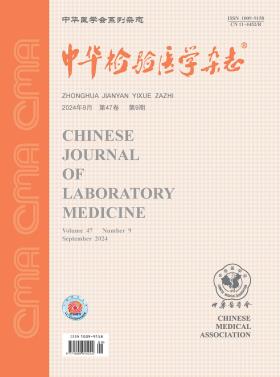Application of cerebrospinal fluid circulating cell-free DNA in the diagnosis and treatment of leptomeningeal metastases from non-small-cell lung cancer
Q4 Health Professions
引用次数: 0
Abstract
Objective To investigate the application value of cerebrospinal fluid circulating cell-free DNA (cfDNA) in the diagnosis and treatment of leptomeningeal metastases in non-small-cell lung cancer (NSCLC). Methods Twenty-five patients with leptomeningeal metastases of NCSLC from Fudan University Huashan Hospital North during the period from September 2017 to November 2018 were enrolled. All 25 patients were confirmed leptomeningeal metastases by cerebrospinal fluid cytology and immunocytochemical staining of cytokeratin(CK7), carcinoembryonic antigen(CEA), thyroid transcription factor-1(TTF-1) and Ki67. The cerebrospinal fluid cfDNA was extracted and genetic variation of 12 genes including epidermal growth factor receptor(EGFR), TP53 and anaplastic lymphoma kinase(ALK) was detected by next-generation sequencing [PlasAim TM gene non-invasive detection of lung cancer (12 gene) kit, Singlera Genomics].The application value of cerebrospinal fluid cfDNA in the diagnosis and treatment of leptomeningeal metastases of NSCLC was analyzed with the cfDNA mutation data and the clinical follow-ups. Results Morphologically typical lung cancer tumor cells with tumor immunochemistry markerCK, CK7 and CEA were found in the cerebrospinal fluid of all 25 patients. Next generation sequencing of cerebrospinal fluid showed that 96% (24/25) patients had at least one single nucleotide variation (SNV) or copy number variation (CNV). The EGFR and TP53 mutations were identified in 80% (20/25) and 48%(12/25) of the patients, respectively. In addition, patients with bone metastases had a higher rate of EGFR mutations than those without bone metastases (100% vs 64%, P<0.05). Changes in the mutant allele frequency of EGFR and TP53 in cerebrospinal fluid were consistent with patients′ disease progression parameters including neurological symptoms, imaging, and tumor biomarkers. The results indicate that genetic alteration of EGFR in cerebrospinal fluid cfDNA is an actionable biomarker for targeted therapy of leptomeningeal metastases of lung cancer. Conclusion Cerebrospinal fluid cfDNA accurately reveals the unique genetic background of leptomeningeal metastasis in NSCLC, showing great application value in the diagnosis and treatment of the leptomeningeal metastasis of NSCLC. Key words: Carcinoma, non-small-cell lung; Neoplasm metastasis; Meningeal neoplasms; Cell-free nucleic acids; Cerebrospinal fluid; High-throughput nucleotide sequencing脑脊液循环游离DNA在非小细胞肺癌脑脊膜转移诊断和治疗中的应用
目的探讨脑脊液循环游离DNA (cfDNA)在非小细胞肺癌(NSCLC)轻脑膜转移诊断和治疗中的应用价值。方法选取2017年9月至2018年11月复旦大学华山北医院收治的25例NCSLC轻脑膜转移患者。25例患者均经脑脊液细胞学及细胞角蛋白(CK7)、癌胚抗原(CEA)、甲状腺转录因子-1(TTF-1)和Ki67免疫细胞化学染色证实为轻脑膜转移。提取脑脊液cfDNA,采用新一代测序[PlasAim TM基因无创检测肺癌(12基因)试剂盒,Singlera Genomics]检测表皮生长因子受体(EGFR)、TP53、间变性淋巴瘤激酶(ALK)等12个基因的遗传变异。结合cfDNA突变数据及临床随访,分析脑脊液cfDNA在非小细胞肺癌脑脊膜转移诊断和治疗中的应用价值。结果25例患者脑脊液中均可见形态典型的肺癌肿瘤细胞,肿瘤免疫化学标志物为ck、CK7和CEA。脑脊液下一代测序显示96%(24/25)患者存在至少一个单核苷酸变异(SNV)或拷贝数变异(CNV)。EGFR和TP53突变分别在80%(20/25)和48%(12/25)的患者中发现。此外,骨转移患者EGFR突变率高于无骨转移患者(100% vs 64%, P<0.05)。脑脊液中EGFR和TP53突变等位基因频率的变化与患者的疾病进展参数(包括神经症状、影像学和肿瘤生物标志物)一致。结果提示脑脊液cfDNA中EGFR的基因改变是肺癌轻脑膜转移靶向治疗的可行生物标志物。结论脑脊液cfDNA准确揭示了非小细胞肺癌小脑膜转移的独特遗传背景,在非小细胞肺癌小脑膜转移的诊断和治疗中具有重要的应用价值。关键词:肺癌,非小细胞肺;肿瘤转移;脑膜瘤;无细胞核酸;脑脊液;高通量核苷酸测序
本文章由计算机程序翻译,如有差异,请以英文原文为准。
求助全文
约1分钟内获得全文
求助全文
来源期刊

中华检验医学杂志
Health Professions-Medical Laboratory Technology
CiteScore
0.40
自引率
0.00%
发文量
8037
期刊介绍:
 求助内容:
求助内容: 应助结果提醒方式:
应助结果提醒方式:


